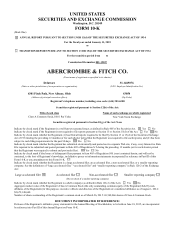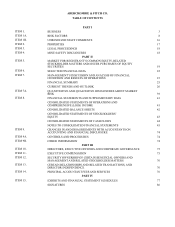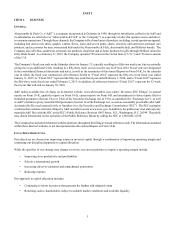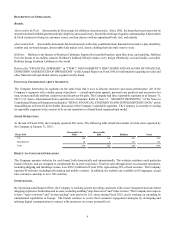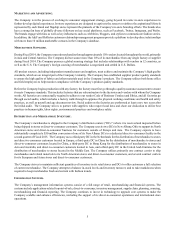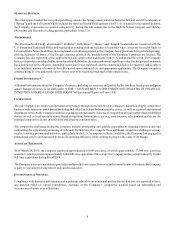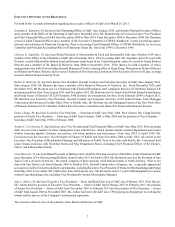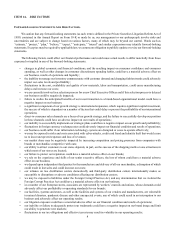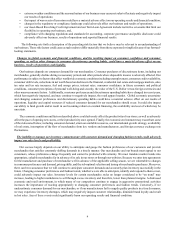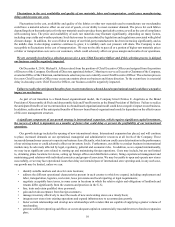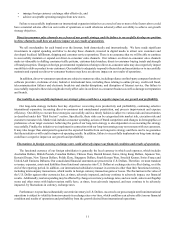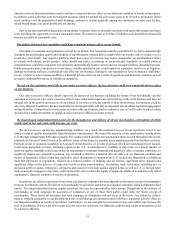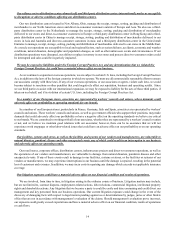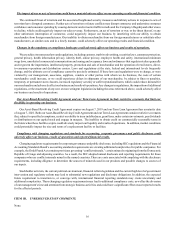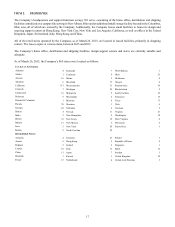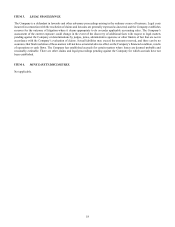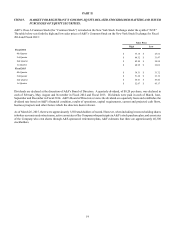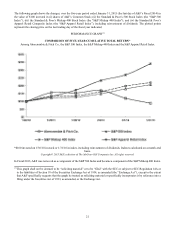Abercrombie & Fitch 2014 Annual Report Download - page 11
Download and view the complete annual report
Please find page 11 of the 2014 Abercrombie & Fitch annual report below. You can navigate through the pages in the report by either clicking on the pages listed below, or by using the keyword search tool below to find specific information within the annual report.
11
• manage foreign currency exchange risks effectively; and
• achieve acceptable operating margins from new stores.
Failure to successfully implement our international expansion initiatives as a result of one or more of the factors above could
have a material adverse effect on our results of operations or could otherwise adversely affect our ability to achieve our growth
strategy objectives.
Direct-to-consumer sales channels are a focus of our growth strategy, and the failure to successfully develop our position
in these channels could have an adverse impact on our results of operations.
We sell merchandise for each brand over the Internet, both domestically and internationally. We have made significant
investments in capital spending and labor to develop these channels, invested in digital media to attract new customers and
developed localized fulfillment, shipping and customer service operations. There is no assurance that we will be able to continue
to successfully maintain or expand our direct-to-consumer sales channels. Our reliance on direct-to-consumer sales channels
make us vulnerable to shifting consumer traffic patterns, customer data breaches, direct-to-consumer buying trends and strength
of brand perception. Changes in foreign governmental regulations relating to direct-to-consumer sales may also negatively impact
our ability to deliver product to our customers. Our inability to adequately respond to these risks and uncertainties or to successfully
maintain and expand our direct-to-consumer business may have an adverse impact on our results of operations.
In addition, direct-to-consumer operations are subject to numerous risks, including reliance on third-party computer hardware/
software providers, violations of state, federal or international laws, including those relating to online privacy, credit card fraud,
telecommunication failures and electronic break-ins and similar disruptions, and disruption of Internet service. Our failure to
successfully respond to these risks might adversely affect sales in our direct-to-consumer business as well as damage our reputation
and brands.
Our inability to successfully implement our strategic plans could have a negative impact on our growth and profitability.
Our long-term strategy includes four key objectives: recovering store productivity and profitability, continuing selective
international expansion, increasing direct-to-consumer and omnichannel penetration, and process improvement and expense
efficiency. Our ability to execute these strategies successfully and in a timely fashion is subject to various risks and uncertainties
as described under this “Risk Factors” section. Specifically, these risks can be categorized into market risk, execution risk and
customer resonance risk. Market risk includes consumer spending, actions of brand competitors and changes in demographics or
preferences of our target customer. Achieving the goals of our long-term strategy is also dependent on us executing the strategy
successfully. Finally, the initiatives we implement in connection with our long-term strategy may not resonate with our customers.
It may take longer than anticipated to generate the expected benefits from our long-term strategy and there can be no guarantee
that these initiatives will result in improved operating results. In addition, failure to successfully implement our long-term strategy
could have a negative impact on our growth and profitability.
Fluctuations in foreign currency exchange rates could adversely impact our financial condition and results of operations.
The functional currency of our foreign subsidiaries is generally the local currency in which each operates, which includes
Australian Dollars, British Pounds, Canadian Dollars, Chinese Yuan, Danish Kroner, Euros, Hong Kong Dollars, Japanese Yen,
Kuwaiti Dinars, New Taiwan Dollars, Polish Zloty, Singapore Dollars, South Korean Won, Swedish Kronor, Swiss Francs and
United Arab Emirates Dirhams. Our consolidated financial statements are presented in U.S. Dollars. Therefore, we must translate
revenues, expenses, assets and liabilities from functional currencies into U.S. Dollars at exchange rates in effect during, or at the
end of the reporting period. In addition, our international subsidiaries transact in currencies other than their functional currency,
including intercompany transactions, which results in foreign currency transaction gains or losses. The fluctuation in the value of
the U.S. Dollar against other currencies has, at times, adversely impacted, and may continue to adversely impact, our financial
results. Additionally, tourism spending may be affected by changes in currency exchange rates, and as a result, sales in our flagship
stores and other stores with higher tourism traffic have, at times, been adversely impacted, and may continue to be adversely
impacted, by fluctuations in currency exchange rates.
Furthermore, we purchase substantially our entire inventory in U.S. Dollars. As a result, our gross margin rate from international
operations is subject to volatility from movements in exchange rates over time, which could have an adverse effect on our financial
condition and results of operations and profitability from the growth desired from international operations.

